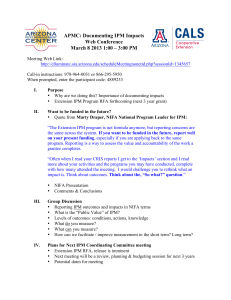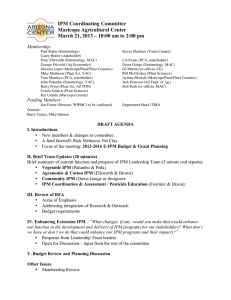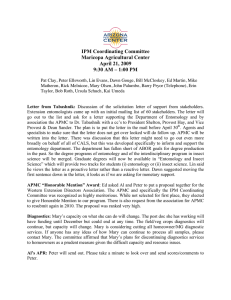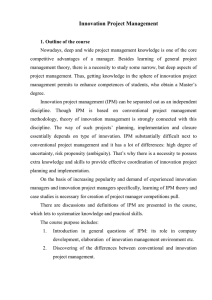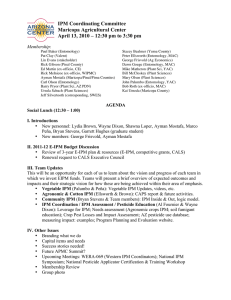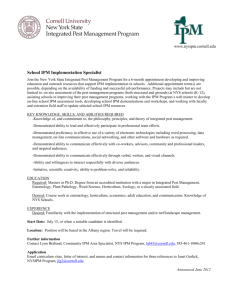IPM Coordinating Committee Maricopa Agricultural Center
advertisement
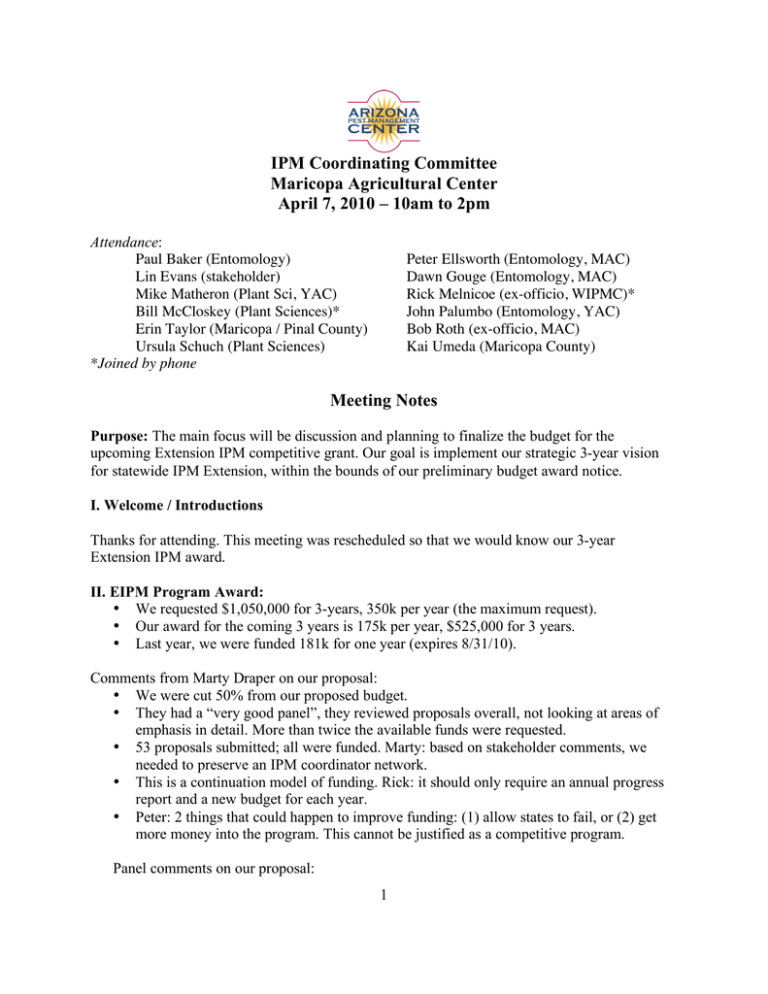
IPM Coordinating Committee Maricopa Agricultural Center April 7, 2010 – 10am to 2pm Attendance: Paul Baker (Entomology) Lin Evans (stakeholder) Mike Matheron (Plant Sci, YAC) Bill McCloskey (Plant Sciences)* Erin Taylor (Maricopa / Pinal County) Ursula Schuch (Plant Sciences) *Joined by phone Peter Ellsworth (Entomology, MAC) Dawn Gouge (Entomology, MAC) Rick Melnicoe (ex-officio, WIPMC)* John Palumbo (Entomology, YAC) Bob Roth (ex-officio, MAC) Kai Umeda (Maricopa County) Meeting Notes Purpose: The main focus will be discussion and planning to finalize the budget for the upcoming Extension IPM competitive grant. Our goal is implement our strategic 3-year vision for statewide IPM Extension, within the bounds of our preliminary budget award notice. I. Welcome / Introductions Thanks for attending. This meeting was rescheduled so that we would know our 3-year Extension IPM award. II. EIPM Program Award: • We requested $1,050,000 for 3-years, 350k per year (the maximum request). • Our award for the coming 3 years is 175k per year, $525,000 for 3 years. • Last year, we were funded 181k for one year (expires 8/31/10). Comments from Marty Draper on our proposal: • We were cut 50% from our proposed budget. • They had a “very good panel”, they reviewed proposals overall, not looking at areas of emphasis in detail. More than twice the available funds were requested. • 53 proposals submitted; all were funded. Marty: based on stakeholder comments, we needed to preserve an IPM coordinator network. • This is a continuation model of funding. Rick: it should only require an annual progress report and a new budget for each year. • Peter: 2 things that could happen to improve funding: (1) allow states to fail, or (2) get more money into the program. This cannot be justified as a competitive program. Panel comments on our proposal: 1 • • • • No specific or significant problems with our proposal. The panel noted that we were trying to hire 2 full time positions. They did not feel EIPM should pick up the tab for this. They said our budget was excessive and focused on the new positions and coordination. Most of our budget is tied up in coordination. We should have had a more detailed outline of collaborations. There was limited evidence of transdisciplinary effort in the proposal. There was too much of an entomology focus; need to bring in weeds & plant pathology. Or maybe it means brining in economics and social sciences. Funding Issues • Marty: the panel wrestled with the definition of Extension. To Marty, it is an integration of applied research and outreach. Some believe Extension is pure outreach. If this latter definition is used, there may be no remaining niche for applied projects. 406 programs were zeroed out of president’s budget (RAMP, CAR, water quality, methyl bromide and IPM Centers). Marty is concerned about the potential loss of the IPM Centers. The 406 funding could get moved into the AFRI program. Rick: President’s budget lacked language to indicate that the Centers should remain intact after funds are moved to AFRI. There are efforts to have Congress restore the 406 program, other efforts to insert language so the programs would stay intact in the AFRI program (Rick is favor of this). USDA wants to get rid of the 406 line item. USDA-NIFA program leaders need to develop language to maintain these programs. Rick is working on setting up a meeting between the AFRI team leaders and the Regional Center coordinators. The IPM Voice group is also trying to influence this process. IPM Voice is a group with IPM interests trying to influence IPM policy. • Ursula: Looking ahead, could we organize an AFRI grant to address many of our IPM needs? Peter: Yes. 35% of AFRI funds will supposedly go to Extension and Outreach. Rick: some programs allow research and extension, other programs are more research focused. Only one or two programs allow Extension only projects. To be successful, AFRI grants have to be multi-state, team-based, and are more project oriented than EIPM. • In 4 to 8 weeks, we should get the formal documentation on our award and will have to do a re-budgeting process. We will have to redefine our scope. How we use the budget is up to us, but we have to budget for 175k each year. • Peter: We should be communicating our comments on the award and the process with USDA, but do so carefully and through this committee and the APMC. • Dawn: On the NIFA conference call recently, she asked how to get community IPM projects funded through NIFA. There appears to be no place for these projects under NIFA. Review of Revised Budget DRAFT • Peter presented a “straw man” revised budget based on our award of 175k per year (available as a separate handout). The guiding principles for this DRAFT budget were to preserve our existing infrastructure first and foremost and to expand staffing levels to the maximum level possible, in part through creative and significant leveraging of existing and potential resources. 2 • • • Peter set up a proposed budget for discussion that seeks to maximize personnel. Goals: retain infrastructure, maximize staffing, identify leveraged funding. The budget presented included almost all dollars in personnel support. By leveraging with other resources, the EIPM could be used to provide partial support for existing infrastructure (Al Fournier, Richard Farmer, Theresa Smith, Tilak Mahoto, Marco Pena, plus 2 Assistants in Extension (AiE) to be hired. The idea is to have 3 AiEs (including Marco), each 50% funded through EIPM, one based in Yuma (Vegetable IPM Team), one at MAC (Agronomic IPM Team, including cotton), and one at Maricopa County (MCCE, Community IPM Team). This may mean a 50% Assistant in Extension (AiE) that has a 50% commitment to some other soft funded project(s). There may be some capacity to get Extension Admin to buy into these county-based positions as well. We reviewed budget (handout provided). PSEP. We have been holding up decisions about how PSEP (Pesticide Safety Education Program) monies will be used this year, in part to determine if funds can be tied in with IPM efforts. Al reviewed a summary of PSEP program outcomes for the past year (separate handout). There were a lot of people reached and CEUs delivered statewide because of the minigrant program. Contingencies • If we are not fully successful in our external grants, how would this committee like to reallocate things? Peter will need an outline from each team leader on what they will propose to do with their modified budget: a new scope of work for each Area of Emphasis (AoE), with a focus on outputs and outcomes. This can include contingency outcomes (if other funding is received). Team leaders should coordinate with others working in their areas to develop for each proposed AoE. • Community IPM: Ursula needs to review the goals put forth in the Community IPM area of emphases. The database for abiotic tree problems was an important objective she would like to retain. Peter liked the comparative study of homeowner’s associations and would like to see that retained, but Ursula does not feel she can accomplish the evaluation with 20% of an AiE. She has identified an RFA that has a chance to support the database. • The Entomology Dept is interviewing to hire a systematist. One of the candidates who wants to develop a database for insect diagnostics, and she (Wendy Moore) already has some funding for it. Peter suggested Ursula talk to Wendy about the project to see if there is a fit with her goals. • Peter: Mike McClure does work on turf nematodes; it is important work. Is there something we could plug into there? • Talk to Monica: could MCCE contribute operational support to the AiE position? • Vegetable IPM: John plans to continue as originally committed, but will probably eliminate the IPM short course, and eliminate the tailgate meetings. • School IPM: Dawn’s most important objectives are to engage public housing and reinvigorate the school IPM program; already committed to the City of Phoenix work to develop intensive training for pest management professionals and will do that anyway. • Urban IPM: Paul has already given some bed bug talks. Was going to do some full fledged workshops through this grant. Based on the cut in funding, he probably will not do these now. 3 • Al & Peter will further discuss plans for infrastructure and how to stretch this funding. Action Items, following discussion: • Peter will revise the budget to get the MCCE AiE to 50%, possibly by contributing some funds from PSEP. • We will keep at least some PSEP funds for minigrants. Al will draft an RFA to be put out ASAP. • The IPM-CC will meet to review PSEP proposals and a revised budget, perhaps in May; Al will send out a Doodle to schedule this. Other Items • We briefly discussed committee membership. We will pursue the idea of adding someone from Ag Econ this committee to enhance our transdisciplinary aspect. We will reevaluate ongoing participation for one or more inactive members. • Application for Center status – This has been on the “back burner” for a while, but Al & Peter are taking steps to establish the APMC as a fully acknowledged Center within the University. There are forms, paperwork, and a plan to sunset review that need to be developed. This is something the committee should take up in the near future. • John Palumbo is developing a plan to form an active statewide Vegetable IPM Team for internal Extension planning (similar to the ICM Team). When time allows, probably June, he will set up an initial meeting for the group. • We also discussed the idea that the IPM-CC / APMC needs to be actively meeting with key stakeholder groups to create more awareness of what we do, to identify priorities and directions, etc. Examples include Arizona Crop Protection Assocation, Western Growers Exec Committee (in AZ 2 weeks ago), Cotton Growers (Dan Thelander), etc. We need to have an organized plan for engaging these groups. We should make a plug for the APMC at DAC next month: The APMC exists, this is what are doing, etc. In John’s presentation, he is going to do a plug for the Veg IPM updates. 4
